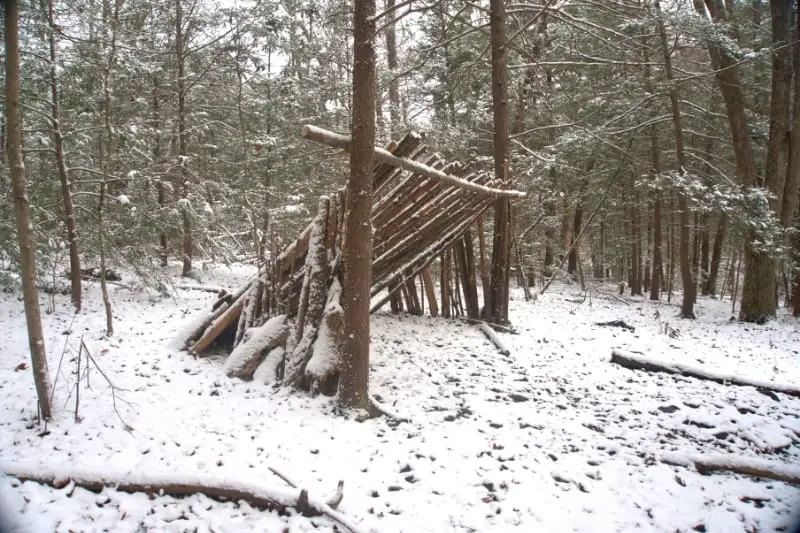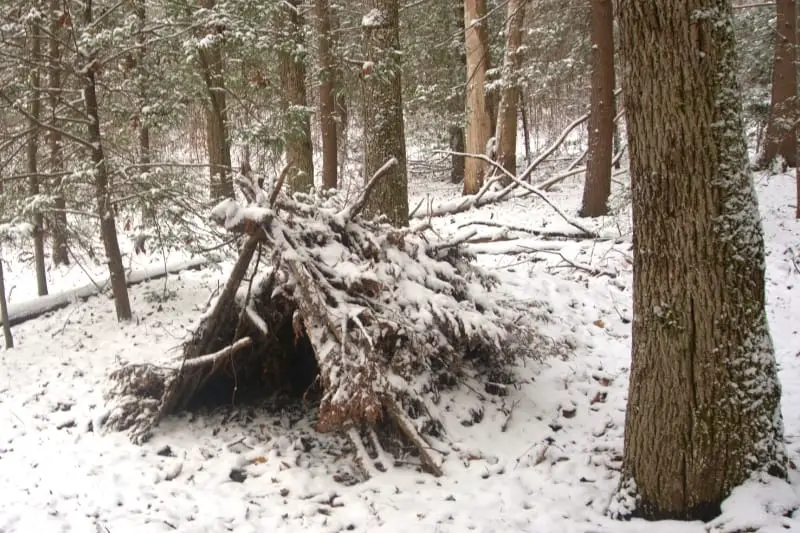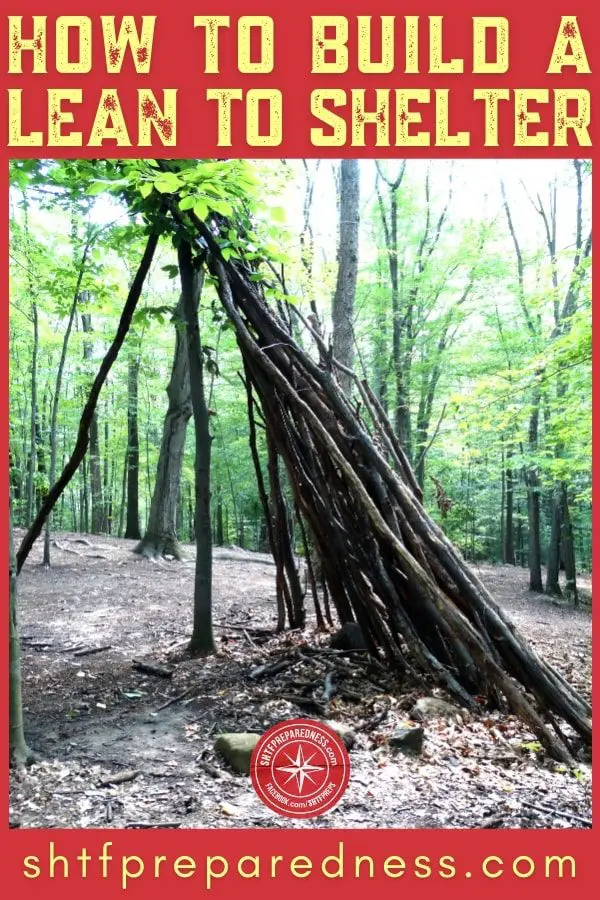SHTFPreparedness may collect a share of sales or other compensation from the links on this page.
The lean-to shelter is one of the simplest and yet most effective types of shelters to build.
In a life-or-death survival situation where you’re exposed to inclement weather, a properly made shelter makes the difference between life and death.
In a survival situation, a fire gives you immediate heat and allows you to cook food. But a shelter keeps you shielded from cold winds, rain, snow, sleet, or whatever else you’re facing.
That’s why building a shelter is just as important as building a fire.
This guide covers the most critical lean-to shelter bushcraft skills to learn, lean-to shelter pros and cons, and how a lean-to shelter compares to other kinds of survival shelters.
Lean-to Basics
Let’s define what a lean-to shelter is in the first place.
What is a Lean-To Shelter?

A lean-to shelter is simply a shelter with poles that lean against one side of a horizontal pole to create a wall. This wall keeps you shielded from the wind, rain, snow, and other elements.
Meanwhile, the other side of the shelter is kept open or facing away from the prevailing winds or rain.
Construct bedding on the ground, insulate the walls, and set up a campfire on the open end for warmth. This completes your lean-to shelter.
Why Is Lean-to the Preferred Emergency Shelter Design?

The short reason why the lean-to is the preferred emergency shelter design is that it’s effective and simple to set up.
You can construct a lean-to shelter in 90 minutes or less if you know what you’re doing, and this makes it one of the least time-consuming survival shelters to construct.
When properly constructed, your lean-to also keeps you properly shielded from the elements as well. Building a shelter is also probably not as difficult as you may think.
Let’s discuss how you can do it.
How to Build a Lean-to Emergency Shelter
Follow these steps to build an emergency lean-to shelter:
Supply List
Acquire the following items to build a primitive lean-to shelter:
- String, rope, paracord, shoelaces, or vine
- Wooden pole (roughly six feet long)
- Poles and sticks of varying sizes made from fallen trees
- Leaves/pine boughs/grass
- Dirt
- Knife or tool with a sharp edge
Location
Be very strategic about your shelter’s location. Make sure the following criteria are met:
- Within walking distance to water (lakes or creeks – avoid stagnant water, which attracts bugs)
- Not exposed to strong winds (i.e. not on the top or open side of a hill)
- Abundant natural resources
- Not in the path or vicinity of natural hazards
Once you’ve found a suitable location, look for two trees roughly five to seven feet apart over relatively flat ground.
Face Away From the Wind
Build the wall of your lean-to against the wind. Determine where the wind is by feeling it. Just close your eyes and turn the wind on your face.
Ensure the wall of the shelter faces the wind.
Building the Structure
Start by resting a pole horizontally between your two trees. The trees must be five to seven feet apart from one another, so you can sprawl out.
Secure this horizontal pole with your rope, paracord, string, vine, or shoelaces.
Then take more poles of a shorter length to construct the wall by resting them against the horizontal pole.
Use string or vine to secure them if you have the resources. Use as many poles and sticks as you can to ensure that there are as few holes as possible.
Weatherproofing, Warmth, and Insulation
Now that the skeleton of your shelter is complete, you can work on weatherproofing and insulating it.
The number one rule when building a lean-to is to ensure the opening doesn’t face the wind. Then fill the open holes of the wall with dirt, leaves, grass, or pine boughs.
Ensure there are no holes that wind or rain could creep through. This is even easier if you have a waterproof tarp to drape over the shelter.
Next, you can build a fire pit on the open side of the shelter. Collect smaller-sized rocks to form a circle, in which you can construct the fire.
The idea is that the wall of your shelter protects you from the rain and wind, while the fire warms you. Use an emergency space blanket to create another wall behind the fire so the heat reflects on you.
Comfort
Just because you’re building a primitive shelter doesn’t mean you can’t make it more comfortable to sleep in.
Remove all rocks and twigs from the ground under your lean-to. Proceed to rest pine needles, pine boughs, and leaves on the ground to serve as bedding.
If you have a garbage bag, you can fill it up with leaves to serve as bedding. Or, if you are prepared, use your sleeping bag or roll.
These leaves and boughs serve two purposes. They insulate you from the cold ground, and they make the ground more comfortable.
Pros and Cons of a Lean-to Shelter
Here are the primary pros and cons of a lean-to shelter:
Pros/Advantages
The three primary advantages of the lean-to shelter are:
- You can set it up fairly quickly
- It’s easy to set up using primitive or simple materials
- It keeps you properly shielded (if constructed properly)
Survival books and guides frequently cite the lean-to as one of the best survival shelters for these reasons. However, there are downsides to the lean-to design as well.
Cons/Disadvantages
The biggest negative to the lean is that it must be positioned correctly against the wind or rain to keep you protected.
In most circumstances, the lean-to is sufficient, but in tougher conditions, such as bad storms, it may not be enough to keep you protected.
The lean-to shelter also must be properly insulated and requires a fire to keep you warm on cold nights. There cannot be a single hole in the wall of the shelter, or else wind can creep through to keep you chilly.
Fortunately, there are alternative shelter designs to explore as well.
Alternative Shelter Designs
There are many survival shelter alternatives to the lean-to, and these include the simple tarp shelter, wickiup, tipi shelter, or tarp bed.
Ultimately, the lean-to may be an effective and easy shelter to construct, but it’s also not the best for all circumstances.
For example, the lean-to could work as a winter survival shelter in a pinch, but other designs provide superior warmth and insulation. Examples include the quinzhee, the snow cave, or the A-frame (essentially a lean-to with the open side covered).
Remember that you don’t really know how to build a lean-to shelter until you’ve built one. You can read dozens of articles like this one on how to build a shelter. But at the end of the day, you need real experience in shelter building to truly know how to build one.
A true survival situation should never be the first time you put your shelter-building skills to the test.
